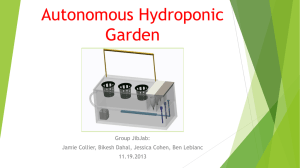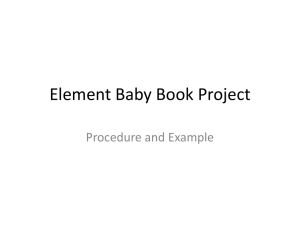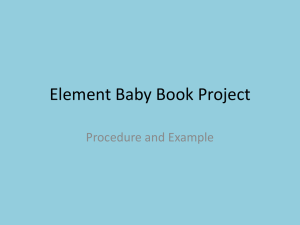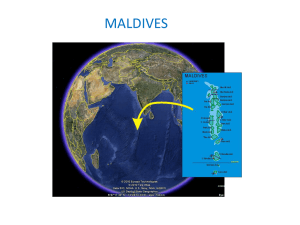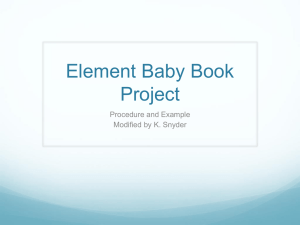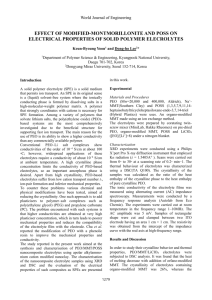Nowe zaprojektowane sole jako elektrolity do baterii litowych
advertisement
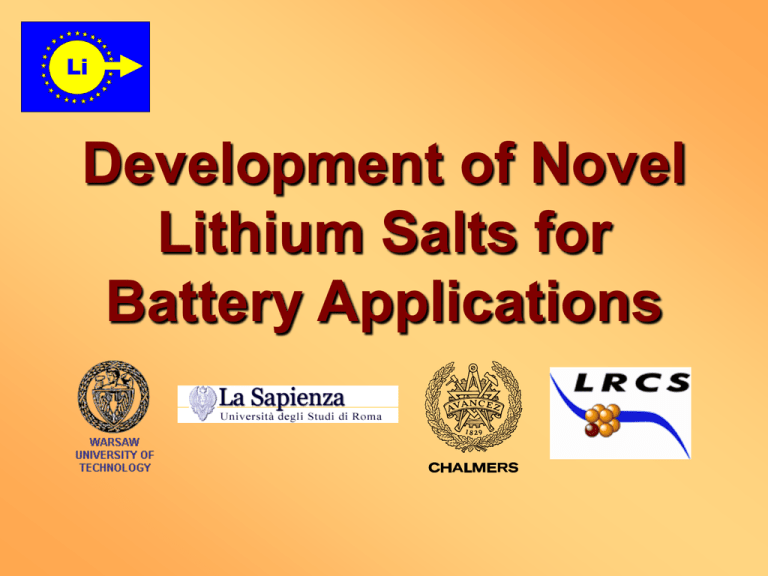
Development of Novel Lithium Salts for Battery Applications Outline of the presentation 1. 2. 3. Introduction – searching for new salts for lithium batteries Synthesis and characterization of novel family of organic covalent lithium salts Properties of polymer and liquid electrolytes containing newly developed salts: • • • • • 4. conductivity lithium transference number formation of ionic aggregates electrochemical stability performance in lithium batteries Conclusions Anions: • Control dissociation and conductivity • Control transport numbers t+ /t- • • are an important part of SEI build-up at +/- electrodes Control aluminium corrosion Classics… BF4- ClO4- Explosive ! Toxic ! PF6- AsF6- SbF6- Tendency to décompose according to equilibrium: LiBF4 BF3 + <LiF> LiPF6 PF5 + <LiF> Fast reaction above 80°C Destruction of electrolyte and interfaces Conceptual approach to anion design “O” is not a favorable building block: Strong Li—O interactions ion pairing, ≠ ClO4-, BOBIf O present, F or CnF2n+1 is required “N, C” are favorable: Weak interactions Li—N but easy oxidation Stability Domains Fluorinated anions LiCoPO LiMO 2 mixed oxides 4 LiMnPO 4 Non fluorinated anions LiFePO 4 LiV 3 O 8 Li 4 Ti 5PO Graphite Li metal 12 Hückel anions… Aromaticity 4n + 2 « » electrons X = N, C-CN, CRF, S(O)RF pKA = 10-60 pKA = 10-20 Gain of > 1 eV by resonance See P. Johansson et al Physical Chemistry Chemical Physics, volume 6, issue 5, (2004). LiDCTA NC CN NC H 2N NH2 O O -2 H 2 O - N- N N N NC CN CN DCTA N - Stable to 3.8 V (La Sapienza, KZ) inexpensive N N NC CN Gives quite fluid ILs N N N N - Most Stable Lithium Imidazole Configurations 1.93 Å 1.88 Å 1.87 Å 1.92 Å LiTDI LiPDI B3LYP/6-311+G(d) Scheers et al. 2009 Gas Phase Ion Pair Dissociation Energies Li+ (g) + Anion- (g) Ion pair (g) LiTDI < LiPDI < LiDCTA < LiTFSI < LiPF6 MP2/6-31G(d) LiTDI LiPDI LiDCTA LiTFSI LiPF6 Scheers et al. 2009 LiTDI (2-trifluoromethyl-4,5dicyanoimidazole lithium salt) O N C NH2 + C N N C CF 3 O C NH2 O C dioxane / T C + Li2CO3 / water C N C CF 3 C N - N+ Li - Easy, low-demanding, inexpensive, one-step, high yield syntheses; - Salts are pure, stable in air atmosphere, non-hygroscopic, stable up to 250°C, easy to handle; CF 3 New salts N N N N - N N N - N Li N + N Li CF 3 N - LiTPI Li LiHDI Li + CF 3 N N N n-C 3 F 7 LiPDI N - + C 2F5 LiTDI N + Conductivity in PEO SS / PEO20LiX / SS 0.01 1E-3 1E-4 -1 conductivity / cm -1 cooling scan 1E-5 1E-6 DCTA LiDCTA PDI LiPDI LiTDI TDI 1E-7 1E-8 2.5 2.6 2.7 2.8 2.9 3.0 3.1 1000/T / K -1 3.2 3.3 3.4 3.5 LiHDI-PEO Conductivity -3 1:25 Li/O 1:50 Li/O -1 log(σ / S·cm ) -4 -5 -6 -7 -8 2,9 3 3,1 3,2 3,3 3,4 3,5 1000·T-1 / K-1 1:25 Ea=76.4 kJ∙mol-1 1:50 Ea=121.8 kJ∙mol-1 T (°C) 127 111 0.01 10 -2 10 -3 10 -4 10 -5 10 -6 10 -7 97 84 72 60 49 39 30 21 13 P(EO)20LiCF3SO3 (Scm ) 1E-4 1E-5 PEO A PEO2020LiTDI PEO LiPDI PEO 20 B 20 1E-6 2.6 2.8 3.0 1000 / T -1 N 0.01 N T / °C 111,5 84 60,1 39,4 21 2,6 2,7 2,8 2,9 3,0 3,1 3,2 3,3 3,4 3,5 -1 1000/T (K ) 0.01 PEO20LiCF3SO3+ ZrO2SA Casting T / °C 111,5 84 60,1 39,4 21 T/°C 111,5 84 60,1 39,4 21 0.01 -1 + 2,5 PEO20LiBOB/ LiBF4 Hot-Pressing PEO20LiDCTA Hot-Pressing CN Conducibilità / Scm Li Conducibilità / Scm -1 1E-3 1E-4 1E-5 1E-4 PEO20 LiDCTA 1E-5 PEO20 LiBF4 1E-8 2.4 2.6 2.8 3.0 3.2 3.4 3.6 -1 -1 1000T / K 1E-7 1E-3 1E-4 1E-5 1E-6 1E-6 1E-7 1E-3 -1 N K 3.2 Conducibilità / Scm NC P(EO)20LiDCTA -1 Conductivity PEO20LiTDI PEO20LiPDI Hot-Pressing S / cm 1E-3 1E-6 PEO20 LiBOB PEO20 LiBF4 1E-8 2.4 2.6 2.8 3.0 3.2 3.4 3.6 -1 -1 1000T / K 1E-7 x: 0% x: 10% 1E-8 2.4 2.6 2.8 3.0 3.2 3.4 3.6 -1 -1 1000T / K Anodic stability Li / PEO LiX / Super P 20 current / mA/cm 2 0.20 DCTA LiDCTA PDI LiPDI TDI LiTDI Anodic breakdown voltage vs. Li 0.15 0.10 0.05 0.00 3.0 3.5 4.0 4.5 5.0 Potential / V 5.5 6.0 6.5 P(EO)20LiDCTA 3.6V P(EO)20LiPDI 4.0V P(EO)20LiTDI 4.0V Interphase resistance - PEO Li / PEO20LiX / Li -60 2h 7h 2d 7d -100 -40 -20 -80 4.5h 1d 5d 12d -60 -40 -20 0 0 0 40 80 120 160 200 0 40 80 Zreal / Ohm 2h 7h 2d 7d -80 -60 LiPDI 4.5h 1d 5d 12d -40 -20 0 0 120 Zreal / Ohm -100 Zimm / Ohm Zimm / Ohm -80 4.5h 1d 5d 12d Zimm / Ohm 2h 7h 2d 7d LiTDI LiDCTA -100 40 80 120 Zreal / Ohm 160 200 160 200 Interphase resistance - PEO Li / PEO20LiX / Li PDIa LiPDIa PDIb LiPDIb LiTDIa TDIa LiTDIb TDIb LiDCTAa DCTAa LiDCTAb DCTAb 240 resistance / Ohm 200 160 120 80 40 0 0 3 6 time / d 9 12 15 Cycling behaviour % of capacity at C/20 Rate capability (PEO) % of capacity at C/20 Rate capability (PEO) LiTDI-PEGDME500 Conductivity -2,5 2M 1M 0.33M 0.1M 0.033M 0.01M -3 -1 log(σ / S·cm ) -3,5 -4 -4,5 -5 -5,5 -6 2,9 3 3,1 3,2 3,3 1000·T-1 / K-1 3,4 3,5 3,6 Transference numbers in PEGDME 500 0.7 LiTDI LiPDI 0.6 LiHDI 0.5 t+ 0.4 0.3 0.2 0.1 0.0 -1 0 1 2 -3 -log(c / mol·dm ) 3 4 5 Cation transference number vs. Ionic conductivity (PEGDME 500) Salt Ionic Conductivity at 1 mol·dm-3 / mS·cm-1 Transference Number at 1 mol·dm-3 LiTPI 0.05 0.61 LiHDI 0.20 0.21 LiPDI 0.26 0.21 LiTDI 0.28 0.17 LiTDI-PEGDME500 Stability vs. Lithium against time 800 1. sample 2. sample 3. sample R / Ω·cm -1 600 400 200 0 0 200 400 t/h 600 800 LiTDI-PC Conductivity -2,5 1M 0.25M 0.1M 0.033M 0.01M 0.0033M 0.001M -1 log(σ / S·cm ) -3 -3,5 -4 -4,5 -5 2,9 3 3,1 3,2 3,3 1000·T-1 / K-1 3,4 3,5 3,6 LiHDI-PC Conductivity -2,5 1M 0.33M 0.1M 0.033M 0.01M 0.0033M 0.001M 0.00033M -1 log(σ / S·cm ) -3 -3,5 -4 -4,5 -5 -5,5 2,9 3 3,1 3,2 3,3 1000·T-1 / K-1 3,4 3,5 3,6 LiTDI-PC Molar Conductivity 50 20°C 40°C 60°C 30 2 Λ / S·cm ·mol -1 40 20 10 0 0 0,2 0,4 0,6 c0.5 / mol0.5·dm-1.5 0,8 1 LiHDI-PC Molar Conductivity 12 20°C 40°C 60°C 8 2 Λ / S·cm ·mol -1 10 6 4 2 0 0 0,2 0,4 0,6 c0.5 / mol0.5·dm-1.5 0,8 1 LiTDI-PC Fuoss-Kraus formalism association estimation % of ions / ion pairs / triplets. 100 80 60 ion pairs triplets "free" ions 40 20 0 0 1 2 3 -log(c) / mol·dm-3 4 5 LiHDI-PC Fuoss-Kraus formalism association estimation % of ions / ion pairs / triplets. 100 80 60 "free" ions ion pairs triplets 40 20 0 0 1 2 3 -log(c) / mol·dm-3 4 5 Transference Numbers in PC 0,5 LiTDI LiPDI LiHDI 0,4 t+ 0,3 0,2 0,1 0,0 0 1 2 3 -3 -log(c / mol·dm ) 4 5 Salts-PC Stability vs. Lithium 0,1 LiTDI LiPDI LiHDI 0,08 0,06 j / mA·cm -2 0,04 0,02 0 -0,02 -0,04 -0,06 -0,08 -0,1 0 1 2 3 E / V vs. Li 4 5 LiTDI Conductivity in EC:DMC -1,5 1M 0.33M 0.1M 0.033M 0.01M -1 log(σ / S·cm ) -2 -2,5 -3 -3,5 -4 2,9 3 3,1 3,2 3,3 1000·T-1 / K-1 3,4 3,5 3,6 Conductivities (20°C) Ragone Signature Anodic limit (Pt, EC-DMC) Anodic limit (Al, EC-DMC) Charge profile 4.3 V cut-off, Al collector Cycling LiMn2O4 4.3 V (EC-DMC) Swagelok cell , Al plunger New imidazole-derived salts • Easy, low-demanding, inexpensive, one-step, high yield syntheses; • Salts are pure, stable in air atmosphere, non-hygroscopic, stable up to 250°C, easy to handle; • 20°C ionic conductivity exceeds: 10-3 S∙cm-1 in PC, 10-4 S∙cm-1 in PEGDME500 10-6 S∙cm-1 in PEO (10-4 S∙cm-1 at 40°C) 6 mS∙cm-1 in EC:DMC • T+ at ionic conductivity maximum reaches: 0.45 in PC, 0.40 in EC-DMC, 0.25 in PEGDME500 (but overall max 0.62); • Stable over time against Li; • Stable up to 4.4 V vs. Li against metallic lithium anode; • Stable up to 5.0 V vs. Li against aluminum; • Much smaller association rate than commercially available salts; Research team working on new salts Presentation of research team working on new lithium salts: Warsaw University of Technology: - L. Niedzicki and W. Wieczorek – characterization of salts and low molecular weight polyether electrolytes - J. Prejzner, P. Szczeciński, M. Bukowska - synthesis of new salts - Z. Żukowska – spectroscopic studies Universite de Picardie Jules Verne, Laboratoire de Reactivite et de Chimie des Solides - S. Grugeon, S. Laruelle - characterization of solid polymeric electrolytes, studies of electrochemical stability and battery performance - and M. Armand – development of new salt systems Faculty of Chemistry, University of Rome, “ La Sapienza - S. Panero, P. Reale and B. Scrosati, - characterization of solid polymeric electrolytes; conductivity, transference numbers and electrochemical stability Department of Applied Physics, Chalmers University of Technology, - J. Scheers, P. Johansson, P. Jacobsson – modeling and spectroscopic studies For inquiries about buying LiTDI N (lithium 4,5-dicyano-2(trifluoromethyl)imidazolate) N N please contact: Leszek Niedzicki asalm@ch.pw.edu.pl - N CF3 LiTDI Li +
